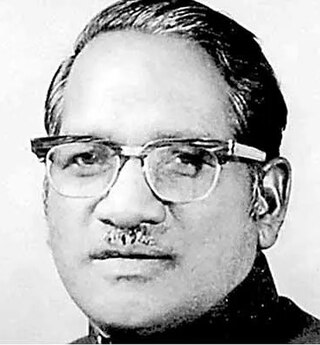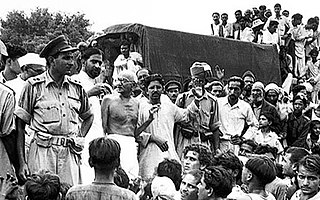
Tana Bhagats is a tribal community in Indian state of Jharkhand. They are related to the historical Tana Bhagat Movement (1914). [1] [2] [3] [4]

Tana Bhagats is a tribal community in Indian state of Jharkhand. They are related to the historical Tana Bhagat Movement (1914). [1] [2] [3] [4]
Tana Bhagats were formed by Oaron saints Jatra Bhagat and Turia Bhagat. Jatra Bhagat of Gumla, Ranchi proclaimed that he was divinely ordained to establish a new sect, the Tana sect, which was markedly different from the Oraon community. The Tanas sought to reorder the Oraon society by opposing the traditional leadership of the pahan (Oraon priest) and mahto (village representative in secular affairs), and by rejecting the practices of spirit worship and sacrifice. In its earlier phase it was called as Kurukh Dharma. Kurukh is original religion of the Oraons. [3]
The Tana Bhagats opposed the taxes imposed on them by the British and they staged nice poga Satyagraha (civil disobedience movement) even before Gandhi's satyagraha movement. They opposed the zamindars, the banias (moneylenders), the missionaries, the Muslims and the British state. Tana Bhagats are followers of Mahatma Gandhi, and believe in Ahimsa (Non-violence). [3]
To observe the 100 years of the movement, a celebration was held with participation of Tana Bhagats from Ranchi, Lohardaga, Latehar and Chatra, besides Gumla districts. [1]

Mohandas Karamchand Gandhi was an Indian lawyer, anti-colonial nationalist and political ethicist who employed nonviolent resistance to lead the successful campaign for India's independence from British rule. He inspired movements for civil rights and freedom across the world. The honorific Mahātmā, first applied to him in South Africa in 1914, is now used throughout the world.

The Indian Independence Movement, was a series of historic events in British India with the ultimate aim of ending British rule in India. It lasted until 1947, when the Indian Independence Act 1947 was passed and India was partitioned.

Jharkhand is a state in eastern India. The state shares its border with the states of West Bengal to the east, Chhattisgarh to the west, Uttar Pradesh to the northwest, Bihar to the north and Odisha to the south. It is the 15th largest state by area, and the 14th largest by population. Hindi is the official language of the state. The city of Ranchi is its capital and Dumka its sub-capital. The state is known for its waterfalls, hills and holy places; Baidyanath Dham, Parasnath, Dewri and Rajrappa are major religious sites. Jharkhand is primarily rural, with about 24% of its population living in cities.
Birsa Munda was an Indian tribal independence activist, and folk hero who belonged to the Munda tribe. He spearheaded a tribal religious millenarian movement that arose in the Bengal Presidency in the late 19th century, during the British Raj, thereby making him an important figure in the history of the Indian independence movement. The revolt mainly concentrated in the Munda belt of Khunti, Tamar, Sarwada and Bandgaon.
Gumla is a city which is the district headquarters in the Gumla subdivision of the Gumla district in the state of Jharkhand, India.

The Kurukh or Oraon, also spelt Uraon or Dhangad, are a Dravidian speaking ethnolinguistic group inhabiting Chhotanagpur Plateau and adjoining areas - mainly the Indian states of Jharkhand, Odisha, Chhattisgarh, and West Bengal. They predominantly speak Kurukh as their native language, which belongs to the Dravidian language family. In Maharashtra, Oraon people are also known as Dhangad.

Kurukh, also Kurux, Oraon or Uranw, is a North Dravidian language spoken by the Kurukh (Oraon) and Kisan people of East India. It is spoken by about two million people in the Indian states of Jharkhand, Chhattisgarh, Odisha, West Bengal, Assam, Bihar and Tripura, as well as by 65,000 in northern Bangladesh, 28,600 of a dialect called Uranw in Nepal and about 5,000 in Bhutan. The most closely related language to Kurukh is Malto; together with Brahui, all three languages form the North Dravidian branch of the Dravidian language family. It is marked as being in a "vulnerable" state in UNESCO's list of endangered languages. The Kisan dialect has 206,100 speakers as of 2011.

Gumla district is one of the twenty-four districts of Jharkhand state, India, and Gumla town is the administrative headquarters of this district.
The tribes of Jharkhand consist of 32 scheduled tribes inhabiting the Jharkhand state in India. In 1872, only 18 tribes were counted among the scheduled tribes from which Banjara, Bhatudi, Chik Baraik, and Mahli were marked as semi-Hindu aboriginal and Kora as proletariat Hindu. In the 1931 census, including the above four semi-Hindu aboriginal and Kora, a proletariat Hindu, the number was raised to 26 from 18. They were Birajia, Godait, Karmali and Paharia, but Kisan was excluded from the list. In the 1941 census, Baga, Bedia and Lohra were included again taking Kisan in the annexure and the number came to 30 which prevailed till June 2003. Kanwar and Kol were added on 8 June 2003 in the annexure and the number of Schedule Tribes came to 32.

Baba Kartik Oraon was an Indian politician and an Adivasi leader from the Indian National Congress. He also participated in the Indian freedom movement of 1947. He founded the Akhil Bharatiya Adivasi Vikas Parishad organisation.
Bharno block is a CD block that forms an administrative division in the Gumla subdivision of Gumla district, in the Indian state of Jharkhand.
Chainpur block is a CD block that forms an administrative division in the Chainpur subdivision of Gumla district, in the Indian state of Jharkhand.

The Champaran Satyagraha of 1917 was the first satyagraha movement led by Mahatma Gandhi in British India and is considered a historically important rebellion in the Indian independence movement. It was a farmer's uprising that took place in Champaran district of Bihar in the Indian subcontinent, during the British colonial period. The farmers were protesting against having to grow indigo with barely any payment for it.
Shriprakash is an Indian activist and independent documentary filmmaker.
The region have been inhabited since the Stone Age. Copper tools from the Chalcolithic period have been discovered. This area entered the Iron Age during the mid-2nd millennium BCE.
Sumati Oraon is an Indian former politician for the Indian National Congress.

Tana Bhagat Movement (1914-1920) was a movement in Chhotanagpur area of British India against the policies of the local British authorities and exploitative business practices of local zamindars, mostly by Oraon people.
The Kol uprising, Kol rebellion, also known in British records as the Kol mutiny was a revolt of the tribal Kol people of Chhota Nagpur that took place between 1831 and 1832. It was due to economic exploitation brought on by the systems of land tenure and administration that had been introduced by the East India Company. Tribal people of Chotanagpur including Mundas, Oraons, Hos and Bhumijs were called Kols. They initially plundered and killed Sikh and Muslims thikedars (contractors) who collected taxes by different means. Later they also started to plunder and kill Hindus of nearby villages and burn their houses. The insurgency was suppressed by killing of the leaders, their followers and arrest of many leaders by Thomas Wilkinson.

Jatra Bhagat (1888–1916) was an Indian tribal freedom fighter and social reformist. He was the founder of Tana Bhagat Movement among the Oraon tribe.
Budhu Bhagat was an Indian freedom fighter. He had led guerrilla warfare against British. He was leader of Kol rebellion and Larka rebellion in 1831—32 in Chhotanagpur.